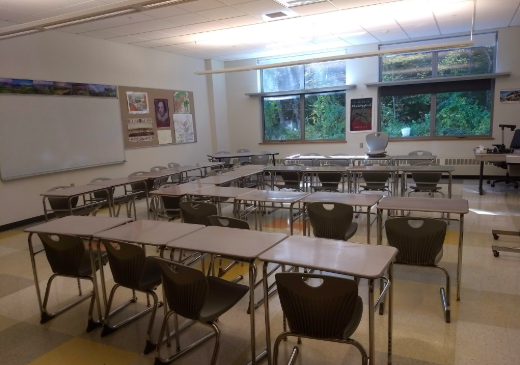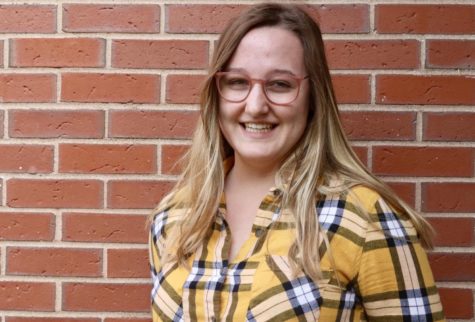WHS administrators visit UNC, efforts underway to diversify staff

Credit: Joanna Barrow
Representatives from Wayland Public Schools flew down to NC to recruit teaching candidates of color. The trip was funded by a state grant. “We all recognize how very important it is that our faculty represent our student population– racially, culturally, et cetera,” Loker Principal Brian Jones said.
October 28, 2019
A team of administrators from Wayland Public Schools visited the University of North Carolina this past May in an effort to recruit teaching candidates of color.
Assistant Superintendent Parry Graham and the principals of Wayland Middle School, Claypit Hill and Loker made the trip to North Carolina to establish connections with universities in the area. The hope is that WPS will then be able to meet, recruit and retain teaching staff through these partnerships.
The trip was made possible by a grant awarded by the Massachusetts Department of Education. The grant aimed to help school districts across Massachusetts in diversifying their workforce, as 92% of all Massachusetts’ teachers are white according to Boston 25 News.
“We all recognize how very important it is that our faculty represent our student population– racially, culturally, et cetera,” Loker Principal Brian Jones said.
In Wayland, there are very few teachers of color. Administrators are aware of the negative impact this can have on all students, especially those struggling to find role models who look like them in their everyday lives.
“The data is very compelling,” WMS Principal Betsy Gavron said. “Particularly for students of color, having just one teacher of color in their K-12 schooling increases the odds of that student earning a bachelor’s degree.”
“[Elementary students] definitely notice when there’s not much diversity,” Claypit Hill Principal Christie Harvey said. “I’ve heard students say something like, ‘I’m the only person who looks like me here.’ I think if we could insert more color into the building, then it would make everyone feel a little less like a minority and more a part of Claypit’s community.”
In the past, representatives from WPS have visited diversity fairs, events designed to help school systems locate teaching candidates of color. However, many of the candidates were not of color.
“Massachusetts’ teaching staff really is not as diverse as it needs to be, given the students in front of us,” Gavron said. “We’ve taken a lot of local efforts to try and really recruit more teachers of color; we go to the local diversity fair each year, but I find when I go there, most of the people looking for jobs look like me.”
The difficulty in finding teachers of color stems from two main obstacles: There aren’t enough teachers of color, and many choose to work in school systems that most resemble those they grew up in. Consequently, towns like Wayland, which are predominantly white, often have trouble recruiting candidates of color.
“A big part of the challenge is that there just aren’t that many people of color going into teacher preparation programs, so there just aren’t that many candidates out there,” Graham said. “Another part of the problem is that schools that tend to be more likely to have non-white, minority candidates tend to be schools that are in more urban centers.”
The issue in having few candidates of color also arises from the general deficiency in students from all backgrounds planning a career in education.
“We in education need to do a better job of marketing ourselves as a really rewarding place to be,” Gavron said. “You hear about how hard and trying the role has become, and how many more things are expected of teachers, and sometimes I think they leave out the amazing parts about teaching and education. I think they really do the profession a disservice. “
WPS also initiated other programs to help make all five schools more culturally responsive.
“The district and the Wayland Public School Foundation funded a diversity and equity coordinator, Caroline Han, to support teachers with making our instructional practice more culturally responsive,” Jones said. “She has been meeting with teachers at all five schools to look more closely at the literature used in classrooms, the conversations we have with students, and taking a closer look at curriculums to make sure that what we’re teaching is representative of all the different cultures we have at our buildings.”
With the new plans implemented, WPS hopes to create a learning environment that supports all students.
“When students have adults who are similar to them, which can be in a variety of different ways, they’re more inclined to feel as though they have people they can trust and have people they feel can understand who they are,” Graham said.





![Last Wednesday, the Wayland School Committee gathered to discuss a number of topics regarding the health curriculum and Innovation Career Pathway course. Another large topic of conversation was the ways to potentially mitigate distracting cell phone usage. "These [phones] are going to distract your learning and social relationships," Superintendent David Fleishman said. "That's concrete right there."](https://waylandstudentpress.com/wp-content/uploads/2025/06/Screenshot-2025-06-04-at-9.49.31 PM-1200x886.png)



























![Troy Hoyt finishes the Boston Marathon, running for the Hoyt Foundation. T. Hoyt is the son of Hoyt Foundation CEO Russ Hoyt.
“[Running a marathon] might seem like a big thing, when it’s presented to you at first, but if you break it up and just keep telling yourself, “Yes, you can,” you can start chipping away at it. And before you know it, you’ll be running the whole 26 miles, and you won’t even think twice about it.” T. Hoyt said.](https://waylandstudentpress.com/wp-content/uploads/2025/04/C36E8761-1CBB-452E-9DF2-543EF7B1095E_1_105_c.jpeg)













































